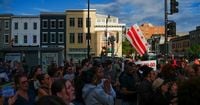Washington, DC, has become the epicenter of a fierce national debate as President Donald Trump’s administration intensifies its crackdown on the city’s criminal justice policies and deploys federal forces throughout the capital. The dual drama unfolding in the nation’s capital—federal occupation and a battle over bail reform—has sparked widespread resistance, creative activism, and renewed questions about fairness, safety, and democracy in America.
In recent weeks, military and law enforcement personnel have flooded DC’s most visible neighborhoods. According to COURIER, these deployments are not random: they target areas popular with tourists and the millennials who moved to the city during the Obama era. The strategy, critics say, is designed to create striking visuals for Trump’s base, projecting an image of order imposed on what he has described as a lawless liberal stronghold. Yet, despite the heavy presence, the city has not witnessed the kind of violent confrontation some feared. Instead, as COURIER reports, there has been a groundswell of creative, even joyful, resistance.
At the forefront of this movement is Free DC, an organization founded by four women who, as The 19th details, began organizing as far back as October 2024—months before Trump announced his plans to send troops and law enforcement into the city. Free DC’s work has included mobilizing rallies for fired federal workers, distributing call sheets to encourage residents to contact members of Congress, sharing requests from groups supporting unhoused residents, and distributing hotlines for reporting the presence of ICE and other federal law enforcement. The group has also organized grassroots efforts to protect youth, stationing adult volunteers near schools and transit stops to counter what one local described as “this moment of overpolicing and autocracy.”
Free DC’s activism is rooted in the city’s unique status: Washingtonians pay federal taxes but lack full representation in Congress, and Congress still controls the city’s budget. This disenfranchisement, as COURIER points out, has made the fight against federal occupation intensely local, allowing organizers to tap into deep networks of activism and advocacy. The occupation, in their eyes, is not just a national spectacle but a direct attack on DC’s autonomy and the rights of its residents.
Residents have responded with a flurry of online activity, documenting every move by federal forces—arrests, patrols, and even harassment—while also showcasing their own acts of resistance. Videos and posts have captured everything from heckling of high-profile Trump allies like JD Vance and Stephen Miller at Union Station to the emergence of “Sandwich Man,” a new folk hero whose image, inspired by a Banksy mural, has become a symbol of the movement. As COURIER describes, Americans have always had a knack for turning outlaws into folk heroes, and DC’s resistance is no exception.
At the heart of Free DC’s approach are five guiding principles: do not obey in advance, prioritize joy, take up space, be in solidarity, and organize. These tenets, the group believes, are essential for sustaining resistance against what they see as an authoritarian regime. “A sustained resistance movement requires all of these components,” COURIER notes. “You can’t win against the Trump Regime without constantly reminding yourself and those around you what you love and why it’s worth fighting for.”
While the city’s activists organize on the ground, President Trump has set his sights on DC’s criminal justice system, particularly its “cashless bail” policy. On August 25, 2025, Trump signed executive orders targeting jurisdictions that have eliminated cash bail, threatening to withhold federal funding and to move certain defendants into federal custody to ensure pre-trial detention. Trump made his position clear: “That was when the big crime in this country started,” he said at the White House. “They kill people, and they get out – cashless bail. They thought it was discriminatory to make people put up money because they just killed three people lying on a street.”
But what exactly is cashless bail, and why has it become so controversial? As CNN explains, cashless bail refers to reforms that replace the traditional money-based bail system with one focused on public safety and defendant rights. Instead of requiring defendants to pay to secure their release before trial, these policies allow judges to consider factors like the severity of the alleged crime and the likelihood of returning to court. Washington, DC, has not required cash bail in most cases since 1992, and several states—both Democratic and Republican-led—have followed suit in recent years.
Advocates for bail reform argue that the old system punished the poor and privileged the wealthy. Insha Rahman, vice president of advocacy and partnerships at Vera Action, told CNN, “The overall justification to move away from a money-bail system is basic fairness. There should not be two systems of justice, one for the poor and one for the rich.” The tragic story of Kalief Browder, a teenager who spent three years in jail because he couldn’t afford $3,000 bail, has become a rallying point for reformers. Browder was never convicted and later died by suicide, a case that drew national attention and inspired legislative efforts, though none have become law at the federal level.
Opponents, however, see bail reform as a dangerous experiment that has led to a “revolving door” of repeat offenders. James Gagliano, a retired FBI agent, told CNN, “You have ‘turnstile justice’ where recidivists have been arrested for the same crime hundreds of times … and you can’t impose bail. It’s wrong and it doesn’t fix the system.” Critics, including Trump, argue that these policies tie judges’ hands and undermine public safety. New York’s bail reform law, for example, has been revised several times in response to concerns about repeat offenders, and even moderate Democrats like Governor Kathy Hochul have called for more judicial discretion.
Yet, research on the impact of bail reform remains mixed. The Brennan Center for Justice analyzed crime data from 33 cities and found no evidence that bail reform increases crime rates. David Olson, co-director of Loyola University Chicago’s Center for Criminal Justice, told CNN that early evidence from Illinois suggests the reforms have had a muted impact: “It doesn’t seem like crime has gone up. It doesn’t seem like failure to appear rates have changed a whole lot.”
Trump’s executive orders, however, represent a sharp escalation in the fight over bail reform, threatening federal funding for jurisdictions that have eliminated cash bail and moving to detain more defendants before trial. Attorney General Pam Bondi has been directed to compile a list of affected states and localities within 30 days. The orders have stoked fears among reform advocates and energized local activists, who see the measures as part of a broader assault on civil rights and local autonomy.
As the standoff continues, Washington’s residents are offering the rest of the country a glimpse of how communities might resist federal overreach—through organizing, solidarity, and, perhaps most importantly, a refusal to surrender joy and hope in the face of adversity. The city’s resistance, both online and in the streets, has become a model for others confronting similar challenges. In the words of Free DC, the fight is not just about policy, but about defending the very soul of the city and its people.


